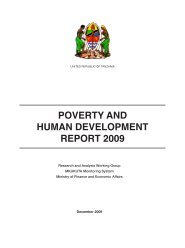Download PDF (4.08 MB) - ReliefWeb
Download PDF (4.08 MB) - ReliefWeb
Download PDF (4.08 MB) - ReliefWeb
You also want an ePaper? Increase the reach of your titles
YUMPU automatically turns print PDFs into web optimized ePapers that Google loves.
124<br />
policymakers to support programmes and policies that create opportunities for employment<br />
and income generation. Adequate resource allocation for strategic communication<br />
should be planned from the start.<br />
7.2.1 Dimensions of strategic communication<br />
Strategic communication has three dimensions: (1) external communication and organizational<br />
advocacy, (2) communication for development (C4D), and (3) internal communication<br />
and knowledge management.<br />
External communication and organizational advocacy. In crisis and post-crisis<br />
situations, UNDP’s external communication and organizational advocacy involves media<br />
outreach and donor relations, with the intended result of raising funds and building partnerships<br />
to support the recovery effort. By managing perceptions and rapidly responding to<br />
partners’ concerns with the use of solid information, this type of communication enables<br />
UNDP to maintain its credibility and strength as a key partner in crisis recovery. Primary<br />
audiences are usually the decision makers among donors and other partners, and secondary<br />
audiences are those who influence them (e.g., constituents, opinion leaders, lobbying<br />
groups, chambers of commerce, or academic associations). Key messages include the<br />
results of existing programming and plans for scaling up. Openness and honesty about<br />
the recovery challenges and the limitations of UNDP’s influence are critical for managing<br />
expectations and demonstrating that UNDP is realistic. Emphasizing the roles of other<br />
partners is also important so as to avoid the perception that UNDP is “going it alone.”<br />
Communication for development. In crisis and post-crisis situations where social<br />
relations are fractured and the public lacks confidence in the government’s capacity<br />
and integrity, communication for development (C4D) can build understanding around<br />
recovery issues and enable crisis-affected people to influence public debate. C4D can<br />
help crisis-affected individuals to participate meaningfully in governance processes by<br />
providing them with the information they need to participate, raising their awareness of<br />
their right to participate, and creating opportunities for them to do so.<br />
Support for community radio stations is an example of a community-level C4D intervention<br />
that can contribute to recovery. Community radio stations can communicate health<br />
information and announce the re-opening of schools and other public services. Furthermore,<br />
these radio stations can provide a platform for dialogue between local authorities<br />
and community leaders, and they can serve as a channel for community members to<br />
express their views and make demands (e.g., through call-in programmes). In post-conflict<br />
situations, t these radio stations can create confidence in the peace process by airing<br />
dialogue among former parties to the conflict.<br />
Since media coverage reflects and influences every aspect of social, cultural, political,<br />
and economic life, media capacity building is an important part of C4D in most crisis and<br />
post-crisis situations. The shift by many donors towards direct budget support heightens<br />
the need for the media to have sufficient capacity to serve its “watchdog” function.<br />
Internal communication and knowledge management. Internal communication<br />
and knowledge management involve (a) information and communication technology<br />
(ICT) that enables storage and transfer of knowledge within an organization and (b)<br />
strategies to ensure that knowledge storage and transfer take place. The Inter-Agency<br />
Standing Committee (IASC) has established the cluster system—with eleven clusters,<br />
Livelihoods & Economic Recovery in Crisis Situations





